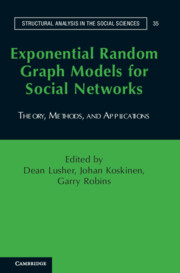Book contents
- Frontmatter
- Contents
- List of Figures
- List of Tables
- 1 Introduction
- Section I Rationale
- Section II Methods
- 6 Exponential Random Graph Model Fundamentals
- 7 Dependence Graphs and Sufficient Statistics
- 8 Social Selection, Dyadic Covariates, and Geospatial Effects
- 9 Autologistic Actor Attribute Models
- 10 Exponential Random Graph Model Extensions: Models for Multiple Networks and Bipartite Networks
- 11 Longitudinal Models
- 12 Simulation, Estimation, and Goodness of Fit
- 13 Illustrations: Simulation, Estimation, and Goodness of Fit
- Section III Applications
- Section IV Future
- References
- Index
- Name Index
7 - Dependence Graphs and Sufficient Statistics
Published online by Cambridge University Press: 05 April 2013
- Frontmatter
- Contents
- List of Figures
- List of Tables
- 1 Introduction
- Section I Rationale
- Section II Methods
- 6 Exponential Random Graph Model Fundamentals
- 7 Dependence Graphs and Sufficient Statistics
- 8 Social Selection, Dyadic Covariates, and Geospatial Effects
- 9 Autologistic Actor Attribute Models
- 10 Exponential Random Graph Model Extensions: Models for Multiple Networks and Bipartite Networks
- 11 Longitudinal Models
- 12 Simulation, Estimation, and Goodness of Fit
- 13 Illustrations: Simulation, Estimation, and Goodness of Fit
- Section III Applications
- Section IV Future
- References
- Index
- Name Index
Summary
Chapter Outline
This chapter is written for those interested in a more detailed understanding of how assumptions regarding various forms of dependence can be formalized. What is treated here is not essential for applying exponential random graph models (ERGMs) and may be skipped at a first reading. The general idea, laid down by Frank and Strauss (1986), is nevertheless crucial to the formulation of statistical models treated in this book.
Important key points in this chapter are as follows:
Subgraph counts are not arbitrarily chosen in ERGMs but correspond to specific dependency structures.
The subgraph counts in ERGMs are intricately nested and interdependent, so care has to be taken in interpreting parameters in isolation.
An ERGM is akin to a log-linear model where the subgraph counts are represented by interactions of tie-variables.
ERGMs try to reduce the complexity of observed networks into systematic underlying principles and stochastic components.
A homogeneous ERGM assigns equal probability to graphs that are structurally identical.
In this chapter, we focus on models for undirected graphs. Dependence graphs for directed models are a natural extension of what we describe here, but we only discuss them briefly.
Information
- Type
- Chapter
- Information
- Exponential Random Graph Models for Social NetworksTheory, Methods, and Applications, pp. 77 - 90Publisher: Cambridge University PressPrint publication year: 2012
Accessibility standard: Unknown
Why this information is here
This section outlines the accessibility features of this content - including support for screen readers, full keyboard navigation and high-contrast display options. This may not be relevant for you.Accessibility Information
- 1
- Cited by
